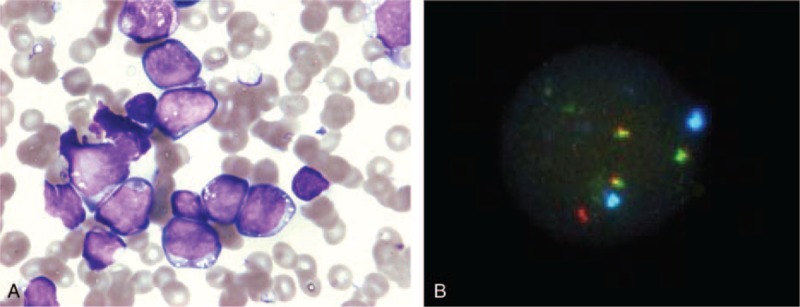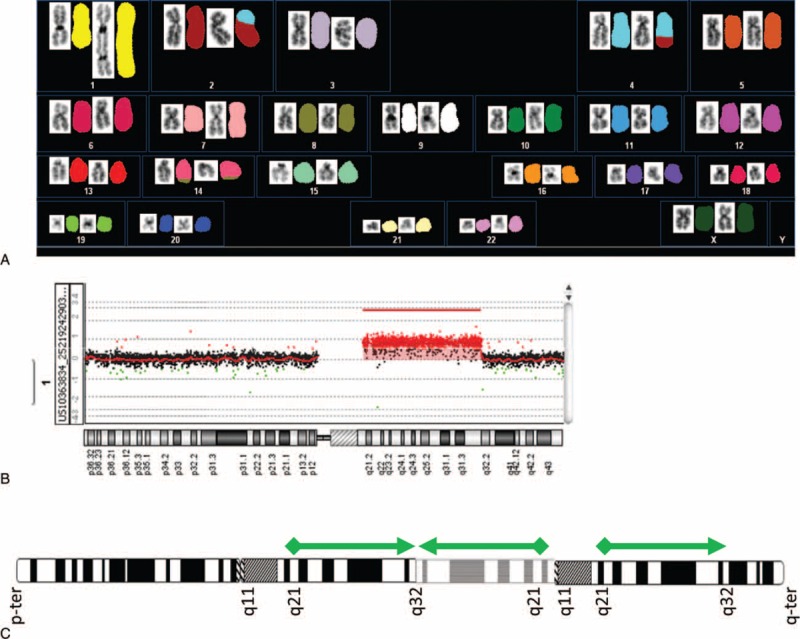Abstract
Free full text

Burkitt-Type Acute Lymphoblastic Leukemia With Precursor B-Cell Immunophenotype and Partial Tetrasomy of 1q
Abstract
Burkitt-type acute lymphoblastic leukemia (B-ALL) is thought as a variant of Burkitt lymphoma/leukemia and derived from mature B-cell lymphoblast.
B-ALL was developed in a 10-year-old girl. Two characteristics were apparent in this case. First, the lymphoblastic cells were positive for CD10, CD19, CD20, and CD22, but negative for terminal deoxynucleotidyl transferase and surface immunoglobulins, indicating a B-cell immunophenotype. The detection of t(8;14)(q24;q32) with a chromosomal analysis is required for a diagnosis of B-ALL. Second, der(1)(pter →
→ q32.1::q32.1
q32.1::q32.1 →
→ q21.1::q11
q21.1::q11 →
→ qter) was detected, in which 1q21.1 to 1q32.1 was inverted and inserted. Finally, partial tetrasomy of 1q was also present. Because B-ALL with abnormal chromosome 1 has been reported poor outcome, the usual chemotherapy for stage 4 Burkitt lymphoma with added rituximab was administered for our patient.
qter) was detected, in which 1q21.1 to 1q32.1 was inverted and inserted. Finally, partial tetrasomy of 1q was also present. Because B-ALL with abnormal chromosome 1 has been reported poor outcome, the usual chemotherapy for stage 4 Burkitt lymphoma with added rituximab was administered for our patient.
We report B-ALL with precursor B-cell immunophenotype and interesting partial tetrasomy of 1q.
INTRODUCTION
Burkitt-type acute lymphoblastic leukemia (B-ALL) is classified as a variant of Burkitt lymphoma/leukemia. A combination of several diagnostic methods, including morphological, cytogenetic, and chromosomal analyses and immunophenotyping, is necessary to diagnose B-ALL with certainty.1,2 B-ALL presents with a French–American–British (FAB) classification L3 morphology and a mature B-cell immunophenotype, with the surface expression of CD20 and surface immunoglobulins with clonally restricted light chains.1,2 According to the 2008 World Health Organization (WHO) classification, a translocation involving MYC, t(8;14)(q24;q32), is highly characteristic of B-ALL, resulting in the constitutive expression of the MYC gene.2,3
In a study by the Pediatric Oncology Group, B-ALL with a precursor B-cell immunophenotype was shown to occur in approximately 0.1% of children with ALL.4–6 Additional chromosomal aberrations can be present, with chromosomes 1, 6, 7, 13, 17, and 22 most commonly affected.2,7 We describe a case of B-ALL with a precursor B-cell immunophenotype and partial tetrasomy of 1q.
Case Report
A 10-year-old girl was admitted to our hospital complaining of lassitude and fever. She displayed hepatosplenomegaly and pleural and abdominal effusions without lymphadenopathy. Lactate dehydrogenase (10,554 U/L; normal range 106–211
U/L; normal range 106–211 U/L) was elevated. A peripheral blood examination showed the following counts: red blood cells 4.25
U/L) was elevated. A peripheral blood examination showed the following counts: red blood cells 4.25 ×
× 1010/L, hemoglobin 11.8
1010/L, hemoglobin 11.8 g/dL, hematocrit 36.2%, platelets 7.3
g/dL, hematocrit 36.2%, platelets 7.3 ×
× 108/L, and white blood cells 4.4
108/L, and white blood cells 4.4 ×
× 107/L, and 48% of leukemic blasts had vacuoles in the cytoplasm (Figure (Figure1A).1A). Leukemic blasts accounted for 73.6% of the mononuclear bone-marrow cells. An immunophenotype analysis was positive for CD10, CD19, CD20, and CD22, and negative for terminal deoxynucleotidyl transferase and surface immunoglobulins, suggesting that the leukemic blasts had a precursor B-cell immunophenotype. A fluorescence in situ hybridization (FISH) analysis revealed an IgH/C-MYC gene fusion (Figure (Figure1B).1B). A G-band-staining chromosomal analysis revealed t(8;14) and an additional abnormality of chromosome 1. A spectral karyotyping FISH analysis and array-based comparative genomic hybridization (aCGH) were performed. A derivative chromosome 1 analysis revealed der(1)(pter
107/L, and 48% of leukemic blasts had vacuoles in the cytoplasm (Figure (Figure1A).1A). Leukemic blasts accounted for 73.6% of the mononuclear bone-marrow cells. An immunophenotype analysis was positive for CD10, CD19, CD20, and CD22, and negative for terminal deoxynucleotidyl transferase and surface immunoglobulins, suggesting that the leukemic blasts had a precursor B-cell immunophenotype. A fluorescence in situ hybridization (FISH) analysis revealed an IgH/C-MYC gene fusion (Figure (Figure1B).1B). A G-band-staining chromosomal analysis revealed t(8;14) and an additional abnormality of chromosome 1. A spectral karyotyping FISH analysis and array-based comparative genomic hybridization (aCGH) were performed. A derivative chromosome 1 analysis revealed der(1)(pter →
→ q32.1::q32.1
q32.1::q32.1 →
→ q21.1::q11
q21.1::q11 →
→ qter), in which region 1q21.1 to 1q32.1 was inverted, inserted (Figure (Figure2A–C),2A–C), and repeated 3 times, causing partial tetrasomy of 1q (Figure (Figure2B2B and C). Another abnormality, t(2;4)(p13;q27), was also detected (Figure (Figure2A).2A). B-ALL with a precursor B-cell immunophenotype and 46,XY,t(8;14)(q24;q32),t(2;4)(p13;q27),der(1)(pter
qter), in which region 1q21.1 to 1q32.1 was inverted, inserted (Figure (Figure2A–C),2A–C), and repeated 3 times, causing partial tetrasomy of 1q (Figure (Figure2B2B and C). Another abnormality, t(2;4)(p13;q27), was also detected (Figure (Figure2A).2A). B-ALL with a precursor B-cell immunophenotype and 46,XY,t(8;14)(q24;q32),t(2;4)(p13;q27),der(1)(pter →
→ q32.1:: q32.1
q32.1:: q32.1 →
→ q21.1::q11
q21.1::q11 →
→ qter) was diagnosed (Figure (Figure22A–C).
qter) was diagnosed (Figure (Figure22A–C).

May–Giemsa staining and fluorescent in situ hybridization analysis. (A) May–Giemsa-staining-based morphological analysis revealed many cytoplasmic vacuoles but inconspicuous granules. The blasts were not typical of the FAB classification of L3. (B) Fluorescent in situ hybridization analysis using an IgH/C-MYC probe. The dual fusion translocation probe hybridized to the nucleus. The 3 yellow spots are IGH/C-MYC fusion gene signals.

G-band-staining-based chromosome analysis, spectral karyotyping fluorescent in situ hybridization (SKY-FISH) analysis, and array-based comparative genomic hybridization (aCGH) array. (A) G-band-stained chromosomes and SKY-FISH suggested 46XY and an additional abnormal karyotype involving t(8;14)(q24;q32), t(2;4)(p13;q27), and der(1)(pter →
→ q32.1::q32.1
q32.1::q32.1 →
→ q21.1::q11
q21.1::q11 →
→ qter). (B) aCGH array of chromosome 1 revealed partial gain of 1q21.1 to 1q32.1. This region conferred the partial tetrasomy of 1q. (C) Schema of chromosome 1.
qter). (B) aCGH array of chromosome 1 revealed partial gain of 1q21.1 to 1q32.1. This region conferred the partial tetrasomy of 1q. (C) Schema of chromosome 1.
Dialysis was performed for tumor lysis syndrome before induction therapy was administered. Complete remission was achieved after B-precursor ALL induction therapy with prednisolone, vincristine, and doxorubicin. The consolidation therapy was adapted from a regimen for advanced Burkitt lymphoma, according to the Japan Pediatric Leukaemia/Lymphoma Study Group B-NHL 03 advanced-stage protocol, including 6 courses of prednisolone, vincristine, cyclophosphamide, methotrexate, pirarubicin, and etoposide. Rituximab was combined with the chemotherapy in last 2 courses. This patient has been in remission for 2 years.
DISCUSSION
B-ALL with a precursor B-cell immunophenotype has been shown to occur in approximately 0.1% of children with ALL, and a chromosomal analysis to detect t(8;14) is required for a correct diagnosis of B-ALL.1–6 Almost all patients suffering B-ALL with a precursor B-cell immunophenotype are administered induction therapy for B-cell ALL, and after a correct diagnosis is made, consolidation chemotherapy for B-ALL is commenced.4,6,8,9 It is unclear whether the progression of B-ALL with a precursor B-cell immunophenotype is worse than that of B-ALL, but because B-ALL is responds well to treatment, B-ALL with a precursor B-cell immunophenotype is expected to behave similarly.
Chromosomal aberrations in addition to t(8;14) are often present in B-ALL, most commonly affecting chromosomes 1, 6, 7, 13, 17, and 22. The most frequent additional aberration involves the long arm of chromosome 1, typically as partial tetrasomy of 1q.2,7,10 The partial tetrasomy of 1q observed in our patient was caused by the inversion and insertion of chromosomal region 1q21.1 to 1q32.1 between 1q32.1 and 1q11. To the best of our knowledge, B-ALL with this partial tetrasomy of 1q, der(1)(pter →
→ q32.1:: q32.1
q32.1:: q32.1 →
→ q21.1::q11
q21.1::q11 →
→ qter), has not previously been reported.
qter), has not previously been reported.
Over 60% of the patients diagnosed with B-ALL and additional aberrations of chromosome 1 relapse or die.2,7,10 In our patient, the partial tetrasomy of 1q arose from the inversion of chromosomal region 1q21.1 to 1q32.1. The duplication of 1q21.1 has been reported in neuroblastoma,11 and the development of familial nonmedullary thyroid cancer has been linked to the distribution of 1q21.1.12 The wide variety of lymphomas associated with an abnormality of 1q21.1 has been also reported, including Burkitt lymphoma.2,10,13–20 It is interesting that malignant neoplasms with 1q21.1 confer poor prognoses. These facts suggest that our patient also has a poor prognosis. However, the partial tetrasomy of 1q involved the chromosomal region from 1q21.1 to 1q32.1, which was not only inserted but also inverted in our patient. We also speculate that the inverted chromosomal region 1q21.1 to 1q32.1 may act as an antisense molecule. The antisense molecule may induce different prognosis compared with malignant neoplasms with 1q21.1.
Based on our hypothesis and the fact that B-ALL with more than 3 cytogenetic abnormalities confers a poor prognosis,7 rituximab was added to the consolidation therapy for B-ALL in our patient to ensure a good outcome.21 The patients have been in complete remission for 3 years since chemotherapy. We also think that stem-cell transplantation would be an effective intervention, but has not been available to our patient because no human leukocyte antigen (HLA)-matched donor has been found.
Acknowledgment
We are grateful for the help of Dr. Toshiyuki Yamamoto, Graduate of Medicine at Tokyo Women's Medical University, for the array-based comparative genomic hybridization analysis.
Footnotes
Abbreviations: aCGH = array-based comparative genomic hybridization, B-ALL = Burkitt-type acute lymphoblastic leukemia, FAB = French–American–British, FISH = fluorescence in situ hybridization, HLA = human leukocyte antigen, WHO = World Health Organization
Consent: The patient and his parents gave their informed consent for the publication of this case report and accompanying images. Ethical approval for this study was waived by the Ethics Committee of Dokkyo Medical University because the study is a single case report.
The authors have no conflicts of interest to disclose.
REFERENCES
Articles from Medicine are provided here courtesy of Wolters Kluwer Health
Citations & impact
Impact metrics
Article citations
Emerging entities: high-grade/large B-cell lymphoma with 11q aberration, large B-cell lymphoma with IRF4 rearrangement, and new molecular subgroups in large B-cell lymphomas. A report of the 2022 EA4HP/SH lymphoma workshop.
Virchows Arch, 483(3):281-298, 09 Aug 2023
Cited by: 5 articles | PMID: 37555980 | PMCID: PMC10541818
Review Free full text in Europe PMC
Molecular characterization and clinical outcome of B-cell precursor acute lymphoblastic leukemia with IG-MYC rearrangement.
Haematologica, 108(3):717-731, 01 Mar 2023
Cited by: 4 articles | PMID: 35484682
Acute Lymphoblastic Leukemia Transformation with a Precursor B-Cell Immunophenotype to Burkitt's Lymphoma: a Case Report.
Caspian J Intern Med, 14(4):760-764, 01 Jan 2023
Cited by: 0 articles | PMID: 38024161 | PMCID: PMC10646355
MLL rearranged acute lymphoblastic leukaemia presenting as a maxillary sinus mass with a discordant immunophenotypic profile from the bone marrow.
BMJ Case Rep, 12(2):e227400, 15 Feb 2019
Cited by: 2 articles | PMID: 30772833 | PMCID: PMC6388888
Similar Articles
To arrive at the top five similar articles we use a word-weighted algorithm to compare words from the Title and Abstract of each citation.
Supernumerary isochromosome 1, idic(1)(p12), leading to tetrasomy 1q in Burkitt lymphoma.
Cytogenet Genome Res, 142(1):7-13, 08 Nov 2013
Cited by: 9 articles | PMID: 24217199
Review
Chromosome abnormalities may correlate with prognosis in Burkitt/Burkitt-like lymphomas of children and adolescents: a report from Children's Cancer Group Study CCG-E08.
J Pediatr Hematol Oncol, 26(3):169-178, 01 Mar 2004
Cited by: 30 articles | PMID: 15125609
'Blastoid' variant of Burkitt lymphoma with additional partial 1q tetrasomy.
Mol Clin Oncol, 8(5):637-639, 05 Mar 2018
Cited by: 1 article | PMID: 29725528 | PMCID: PMC5920494
Adult precursor-B acute lymphoblastic leukemia with translocations involving chromosome band 19p13 is associated with poor prognosis.
Cancer Genet Cytogenet, 109(1):58-65, 01 Feb 1999
Cited by: 12 articles | PMID: 9973961




